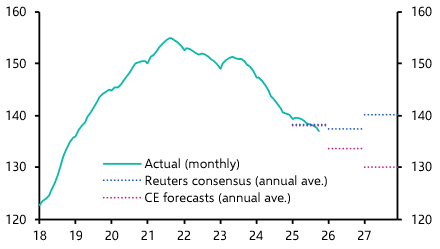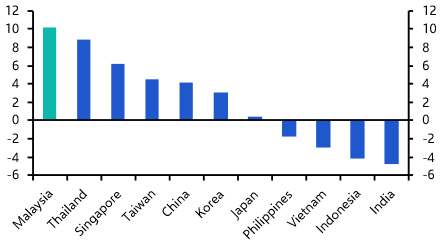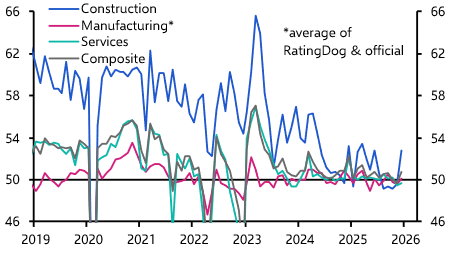With Q2 behind us, now seems a good time to revisit some of the forecasts for 2019 that we made at the start of the year. At the risk of blowing our trumpet too hard, I think – with one or two exceptions – we’ve so far got the big calls right.
The predominant issue at turn of the year was whether the downturn in the global economy in the final few months of 2018 would prove to be a temporary soft patch or whether the weakness would persist into 2019 and perhaps beyond. We sat in the latter camp. In my final note of 2018 I said that: “The main point to emphasise is that we expect the global economy to slow next year, and by more than most currently anticipate”.
I think this view has been generally vindicated, both by the incoming data but also recent market moves. Admittedly, first quarter GDP growth surprised on the upside in both Europe and the US. But this was due in large part to temporary factors that have since faded. The recent activity and survey data both point to a much softer Q2 – indeed, we think that global GDP growth may have slowed to 2.9% y/y, which would be the weakest outturn since 2016.
We can also claim wins on two big political issues. At the start of the year we argued that a combination of fudge and delay would ensure that the UK would avoid a “no deal” Brexit on March 29th. And on the US-China trade war I argued that “there is a good chance that we shift from a US-China trade war, centred on tariffs and trade balances, to a US-China tech war, centred on intellectual property, industrial strategy and national security”. This is broadly how things have played out.
So far, so good. But there are two areas where events have developed a little differently to how we had anticipated. First, the debate around monetary policy has evolved more quickly than even we had thought likely. At the start of the year, we were one of only a handful of analysts arguing that the policy tightening priced into markets, particularly in the US, was too aggressive and that economic weakness would force the Fed to cut interest rates in 2020. We were on the right side of the argument and, as a result, we were correct to forecast a sharp drop in US Treasury yields this year. But it’s fair to say that the rhetoric from policymakers has shifted more quickly than we expected.
The second surprise has been that concerns about the outlook for growth (and the associated drop in bond yields) has come alongside a broad-based rally in global equities over the past six months. This is something of a conundrum, to which I’ll return later.
So what happens next? The short answer is that we think the weakness of both growth and inflation will remain the dominant concerns over the remainder of this year and into 2020. Our forecasts for GDP growth in the US and Europe remain below the current consensus, and China’s economy is likely to struggle too. Aggregate global GDP growth is likely to slow to its weakest rate since the global financial crisis.
Accordingly, policymakers will have to back their recent dovish tilt with action. Over the remainder of this year, we expect central banks in the US, euro-zone and China to loosen policy. (Read more here and here.) That being said, the sharp drop in bond yields over the past few weeks means that this is now largely priced into markets. As a result, despite the fact that we expect widespread monetary easing, it’s difficult to see further upside for government bonds from here.
Of the various political risks stalking the global economy, the US-China trade war will remain front and centre over the coming weeks and months. This weekend’s news that Washington and Beijing will restart negotiations is clearly positive, but a durable settlement on the more thorny issues around intellectual property and industrial strategy will be difficult. Discussions between the US and China will ebb and flow, but the general trend over the next year is therefore likely to be towards further escalation in the trade war. If we’re right, one consequence would be a weaker renminbi.
The big question in all of this is what does this mean for global stock markets? There are two potential explanations for the strength of equities over the past six months. The first is that investors believe that the world’s central banks, led by the Fed, will save the day and that policy easing will stimulate growth that in turn supports equity prices. The second, less optimistic, explanation is that the equity market is simply lagging behind the bond market and it will eventually succumb to the realities of a more challenging growth outlook.
There are echoes in the first explanation of the experience of 1995-96, when Fed easing did produce a rebound in the stock market. But this came alongside a productivity-led upswing in the US economy. We wouldn’t rule out a repeat this time around, but it’s not in our baseline forecast. Instead, we suspect that the US stock market will falter over the second half of this year, and that this weakness will then weigh on equity markets elsewhere in the world. If we’re right then, with bond yields at a floor and equity markets near a peak, investors will face a challenging remainder or 2019.
In case you missed it:
(Requires login)
- Our Senior Economic Adviser, Vicky Redwood, looks at the risks posed by Facebook’s new currency, Libra.
- Our US team has published their Quarterly Outlook, which forecasts a sharp slowdown in growth over the rest of this year.
- Our Commodities team explains why OPEC+ is likely to rollover output cuts for another six months when it meets this week.




